
Frederick William Cumberland
Encyclopedia
Frederick William Cumberland (10 April 1821 – 5 August 1881) was a Canadian engineer, architect
and political figure. He represented the riding of Algoma
in the 1st
and 2nd Ontario Parliaments
and in the Canadian House of Commons
from 1871 to 1872.
, England
in 1821, and grew up in Rathmines
, Dublin, where his father was employed at Dublin Castle
. His mother died there. The family returned to London in the mid-1830s, and he studied at King's College School
and apprenticed as a civil engineer
. Starting in 1843, he was employed with the engineering department of the British Admiralty, working on the construction of dry dock
s and fortifications. In 1845, he married Wilmot Mary Bramley, whose sisters had married prominent men in the city of Toronto
, and he came to that city with his wife in 1847.
He worked there as a surveyor and as engineer for the united counties of York
and Peel
. In partnership with Thomas Ridout
, he designed Cathedral Church of St. James (Toronto)
and School, the York County Court House and a Post Office.
Later, with William George Storm
, he designed other important public buildings in the city. At the University of Toronto
, he designed University College
, Provincial Magnetic Observatory (1853-55); Director's Residence, 1858 which was demolished in 1901; and major additions and reconstruction of the Centre Block, 1856-59 of Osgoode Hall
law courts.
He designed residences for important people living in the city. He designed the Queen Street Wesleyan Chapel, 1856 which was demolished c. 1980. He also built several public buildings at Hamilton
.
During the 1850s, Cumberland became involved in railway management at the Ontario, Simcoe and Huron Railroad Union Company, later the Northern Railway
Company, and other railway and related companies of the time. From 1868 Cumberland served as a director of the Rama Timber Transport Company
. As was common at the time, he used railway money to gain the support of Members of Parliament and to help elect candidates favourable to their cause. After Cumberland's death, the Northern Railway Company was absorbed by the Grand Trunk Railway
. He was also director at a number of banks and a member of the Toronto Board of Education. He also helped establish a new battalion in the local militia during the 1860s. He was a member of the senate of the University of Toronto. He was a freemason, becoming deputy grand master for the Toronto district.
He died in Toronto in 1881.
Architect
An architect is a person trained in the planning, design and oversight of the construction of buildings. To practice architecture means to offer or render services in connection with the design and construction of a building, or group of buildings and the space within the site surrounding the...
and political figure. He represented the riding of Algoma
Algoma—Manitoulin (provincial electoral district)
Algoma—Manitoulin is a provincial electoral district in Ontario, Canada, that has been represented in the Legislative Assembly of Ontario since 1934....
in the 1st
1st Parliament of Ontario
The 1st Parliament of Ontario was in session from September 3, 1867 until February 25, 1871, just prior to the 1871 general election. This was the first session of the Legislature after Confederation succeeding the Legislative Assembly of the Province of Canada...
and 2nd Ontario Parliaments
2nd Parliament of Ontario
The 2nd Parliament of Ontario was in session from March 21, 1871 until December 23, 1874, just prior to the 1875 general election. The majority party was the Ontario Liberal Party led by Edward Blake; Oliver Mowat replaced Blake as premier in October 1872...
and in the Canadian House of Commons
Canadian House of Commons
The House of Commons of Canada is a component of the Parliament of Canada, along with the Sovereign and the Senate. The House of Commons is a democratically elected body, consisting of 308 members known as Members of Parliament...
from 1871 to 1872.
Biography
William Cumberland was born in LondonLondon
London is the capital city of :England and the :United Kingdom, the largest metropolitan area in the United Kingdom, and the largest urban zone in the European Union by most measures. Located on the River Thames, London has been a major settlement for two millennia, its history going back to its...
, England
England
England is a country that is part of the United Kingdom. It shares land borders with Scotland to the north and Wales to the west; the Irish Sea is to the north west, the Celtic Sea to the south west, with the North Sea to the east and the English Channel to the south separating it from continental...
in 1821, and grew up in Rathmines
Rathmines
Rathmines is a suburb on the southside of Dublin, about 3 kilometres south of the city centre. It effectively begins at the south side of the Grand Canal and stretches along the Rathmines Road as far as Rathgar to the south, Ranelagh to the east and Harold's Cross to the west.Rathmines has...
, Dublin, where his father was employed at Dublin Castle
Dublin Castle
Dublin Castle off Dame Street, Dublin, Ireland, was until 1922 the fortified seat of British rule in Ireland, and is now a major Irish government complex. Most of it dates from the 18th century, though a castle has stood on the site since the days of King John, the first Lord of Ireland...
. His mother died there. The family returned to London in the mid-1830s, and he studied at King's College School
King's College School
King's College School, commonly referred to as KCS, King's, or KCS Wimbledon, is an independent school for day pupils in Wimbledon in south-west London. The school was founded as the junior department of King's College London and occupied part of its premises in Strand, before relocating to...
and apprenticed as a civil engineer
Civil engineer
A civil engineer is a person who practices civil engineering; the application of planning, designing, constructing, maintaining, and operating infrastructures while protecting the public and environmental health, as well as improving existing infrastructures that have been neglected.Originally, a...
. Starting in 1843, he was employed with the engineering department of the British Admiralty, working on the construction of dry dock
Dry dock
A drydock is a narrow basin or vessel that can be flooded to allow a load to be floated in, then drained to allow that load to come to rest on a dry platform...
s and fortifications. In 1845, he married Wilmot Mary Bramley, whose sisters had married prominent men in the city of Toronto
Toronto
Toronto is the provincial capital of Ontario and the largest city in Canada. It is located in Southern Ontario on the northwestern shore of Lake Ontario. A relatively modern city, Toronto's history dates back to the late-18th century, when its land was first purchased by the British monarchy from...
, and he came to that city with his wife in 1847.
He worked there as a surveyor and as engineer for the united counties of York
York County, Ontario
York County is a historic county in Upper Canada, Canada West, and the Canadian province of Ontario.York County was created in 1792 and was part of the jurisdiction of Home District of Upper Canada...
and Peel
Peel County, Ontario
Peel County is a historic county in the Canadian province of Ontario. It was created in 1851 from a portion of York County. In 1973, Peel County became the Regional Municipality of Peel, as a result of the Ontario provincial government's regionalization of the rapidly developing counties...
. In partnership with Thomas Ridout
Thomas Ridout
Thomas Ridout was a political figure in Upper Canada.He was born in Sherborne, England in 1754 and came to Maryland in 1774. In 1787, he was travelling to Kentucky when his group was captured by a party of Shawnees; he was held captive and later released in Detroit, then held by the British...
, he designed Cathedral Church of St. James (Toronto)
Cathedral Church of St. James (Toronto)
Cathedral Church of St. James in Toronto, Canada is the home of the oldest congregation in the city. The parish was established in 1797. The Cathedral was begun in 1850 and completed in 1853, was at the time one of the largest buildings in the city...
and School, the York County Court House and a Post Office.
Later, with William George Storm
William George Storm
William George Storm was a Canadian architect who designed a number of prominent monuments in Toronto.He was born in England and immigrated to Canada while still a child and was raised in Cobourg, Ontario. His father was a contractor and introduced him to the building trade. He apprenticed first...
, he designed other important public buildings in the city. At the University of Toronto
University of Toronto
The University of Toronto is a public research university in Toronto, Ontario, Canada, situated on the grounds that surround Queen's Park. It was founded by royal charter in 1827 as King's College, the first institution of higher learning in Upper Canada...
, he designed University College
University College, University of Toronto
University College is a constituent college of the University of Toronto, created in 1853 specifically as an institution of higher learning free of religious affiliation. It was the founding member of the university's modern collegiate system, and its secularism contrasted with contemporary...
, Provincial Magnetic Observatory (1853-55); Director's Residence, 1858 which was demolished in 1901; and major additions and reconstruction of the Centre Block, 1856-59 of Osgoode Hall
Osgoode Hall
Osgoode Hall is a landmark building in downtown Toronto constructed between 1829 and 1832 in the late Georgian Palladian and Neoclassical styles. It houses the Ontario Court of Appeal, the Divisional Court of the Superior Court of Justice, and the Law Society of Upper Canada...
law courts.
He designed residences for important people living in the city. He designed the Queen Street Wesleyan Chapel, 1856 which was demolished c. 1980. He also built several public buildings at Hamilton
Hamilton, Ontario
Hamilton is a port city in the Canadian province of Ontario. Conceived by George Hamilton when he purchased the Durand farm shortly after the War of 1812, Hamilton has become the centre of a densely populated and industrialized region at the west end of Lake Ontario known as the Golden Horseshoe...
.
During the 1850s, Cumberland became involved in railway management at the Ontario, Simcoe and Huron Railroad Union Company, later the Northern Railway
Northern Railway of Canada
The Northern Railway of Canada was a historical Canadian railway located in the province of Ontario. It was eventually acquired by the Grand Trunk Railway, and is therefore a predecessor to the modern Canadian National Railway.- Early history :...
Company, and other railway and related companies of the time. From 1868 Cumberland served as a director of the Rama Timber Transport Company
Rama Timber Transport Company
The Rama Timber Transport Company was a Canadian canal and railway company that was incorporated in 1868 to construct and operate the Black River & Lake St...
. As was common at the time, he used railway money to gain the support of Members of Parliament and to help elect candidates favourable to their cause. After Cumberland's death, the Northern Railway Company was absorbed by the Grand Trunk Railway
Grand Trunk Railway
The Grand Trunk Railway was a railway system which operated in the Canadian provinces of Quebec and Ontario, as well as the American states of Connecticut, Maine, Michigan, Massachusetts, New Hampshire, and Vermont. The railway was operated from headquarters in Montreal, Quebec; however, corporate...
. He was also director at a number of banks and a member of the Toronto Board of Education. He also helped establish a new battalion in the local militia during the 1860s. He was a member of the senate of the University of Toronto. He was a freemason, becoming deputy grand master for the Toronto district.
He died in Toronto in 1881.
Works
| Building | Year Completed | Builder | Style | Source | Location | Image |
|---|---|---|---|---|---|---|
| Ryerson University Ryerson University Ryerson University is a public research university located in downtown Toronto, Ontario, Canada. Its urban campus is adjacent to Yonge-Dundas Square located at the busiest intersection in Downtown Toronto. The majority of its buildings are in the blocks northeast of the square in Toronto's Garden... , then Toronto Normal School |
1852 | Frederick Cumberland Frederick William Cumberland Frederick William Cumberland was a Canadian engineer, architect and political figure. He represented the riding of Algoma in the 1st and 2nd Ontario Parliaments and in the Canadian House of Commons from 1871 to 1872.... and Thomas Ridout Thomas Ridout Thomas Ridout was a political figure in Upper Canada.He was born in Sherborne, England in 1754 and came to Maryland in 1774. In 1787, he was travelling to Kentucky when his group was captured by a party of Shawnees; he was held captive and later released in Detroit, then held by the British... (Design) |
Gothic Revival architecture Gothic Revival architecture The Gothic Revival is an architectural movement that began in the 1740s in England... Romanesque |
3 | St James Square, bounded by Gerrard, Church, Younge and Gould, Toronto, Ontario |  |
| Consumers' Gas Building | 1852 | Frederick Cumberland Frederick William Cumberland Frederick William Cumberland was a Canadian engineer, architect and political figure. He represented the riding of Algoma in the 1st and 2nd Ontario Parliaments and in the Canadian House of Commons from 1871 to 1872.... and Thomas Ridout Thomas Ridout Thomas Ridout was a political figure in Upper Canada.He was born in Sherborne, England in 1754 and came to Maryland in 1774. In 1787, he was travelling to Kentucky when his group was captured by a party of Shawnees; he was held captive and later released in Detroit, then held by the British... (Design) |
Neo-Renaissance Neo-Renaissance Renaissance Revival is an all-encompassing designation that covers many 19th century architectural revival styles which were neither Grecian nor Gothic but which instead drew inspiration from a wide range of classicizing Italian modes... Revival |
3 | Toronto Street, Toronto, Ontario | 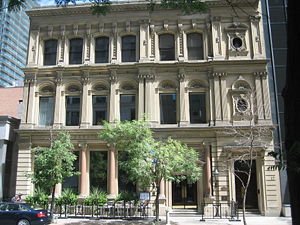 |
| Adelaide Street Court House Adelaide Street Court House The Adelaide Street Court House, or York County Court House, was built in 1851-1862 by Thomas Ridout.Located at 57 Adelaide Street East in the St. Lawrence, Toronto, neighbourhood, the building was later home to the Arts and Letters Club of Toronto. In recent years, it housed the Courthouse Market... |
1852 | Frederick Cumberland Frederick William Cumberland Frederick William Cumberland was a Canadian engineer, architect and political figure. He represented the riding of Algoma in the 1st and 2nd Ontario Parliaments and in the Canadian House of Commons from 1871 to 1872.... and Thomas Ridout Thomas Ridout Thomas Ridout was a political figure in Upper Canada.He was born in Sherborne, England in 1754 and came to Maryland in 1774. In 1787, he was travelling to Kentucky when his group was captured by a party of Shawnees; he was held captive and later released in Detroit, then held by the British... (Design) |
Greek Revival architecture Greek Revival architecture The Greek Revival was an architectural movement of the late 18th and early 19th centuries, predominantly in Northern Europe and the United States. A product of Hellenism, it may be looked upon as the last phase in the development of Neoclassical architecture... |
3 | 57 Adelaide Street East, Toronto, Ontario | 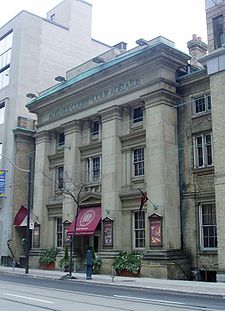 |
| Toronto Street Post Office Toronto Street Post Office The Toronto Street Post Office was also called Seventh Toronto Post Office and was built by Frederick William Cumberland and Thomas Ridout from 1851 to 1853. It is designed in the Greek Revival style.... |
1853 | Frederick Cumberland Frederick William Cumberland Frederick William Cumberland was a Canadian engineer, architect and political figure. He represented the riding of Algoma in the 1st and 2nd Ontario Parliaments and in the Canadian House of Commons from 1871 to 1872.... and Thomas Ridout Thomas Ridout Thomas Ridout was a political figure in Upper Canada.He was born in Sherborne, England in 1754 and came to Maryland in 1774. In 1787, he was travelling to Kentucky when his group was captured by a party of Shawnees; he was held captive and later released in Detroit, then held by the British... (Design) |
Greek Revival architecture Greek Revival architecture The Greek Revival was an architectural movement of the late 18th and early 19th centuries, predominantly in Northern Europe and the United States. A product of Hellenism, it may be looked upon as the last phase in the development of Neoclassical architecture... |
2, 3 | 10 Toronto Street, Toronto, Ontario | 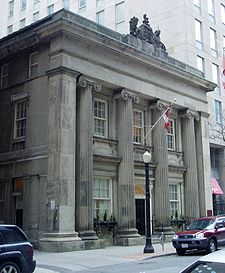 |
| Cathedral Church of St. James Cathedral Church of St. James (Toronto) Cathedral Church of St. James in Toronto, Canada is the home of the oldest congregation in the city. The parish was established in 1797. The Cathedral was begun in 1850 and completed in 1853, was at the time one of the largest buildings in the city... |
1853 | Frederick Cumberland Frederick William Cumberland Frederick William Cumberland was a Canadian engineer, architect and political figure. He represented the riding of Algoma in the 1st and 2nd Ontario Parliaments and in the Canadian House of Commons from 1871 to 1872.... and Thomas Ridout Thomas Ridout Thomas Ridout was a political figure in Upper Canada.He was born in Sherborne, England in 1754 and came to Maryland in 1774. In 1787, he was travelling to Kentucky when his group was captured by a party of Shawnees; he was held captive and later released in Detroit, then held by the British... (Design) |
Gothic Revival architecture Gothic Revival architecture The Gothic Revival is an architectural movement that began in the 1740s in England... |
King and Church Streets, Toronto, Ontario | 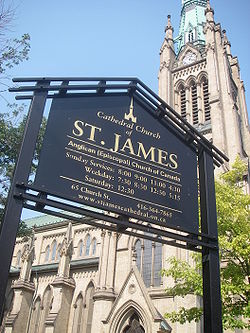 |
|
| Louis B. Stewart Observatory/Toronto Magnetic and Meteorological Observatory Toronto Magnetic and Meteorological Observatory The Toronto Magnetic and Meteorological Observatory is a historical observatory located on the grounds of the University of Toronto, in Toronto, Ontario, Canada. The original building was constructed in 1840 as part of a worldwide research project run by Edward Sabine to determine the cause of... |
1853–1857 | Frederick William Cumberland Frederick William Cumberland Frederick William Cumberland was a Canadian engineer, architect and political figure. He represented the riding of Algoma in the 1st and 2nd Ontario Parliaments and in the Canadian House of Commons from 1871 to 1872.... and William George Storm William George Storm William George Storm was a Canadian architect who designed a number of prominent monuments in Toronto.He was born in England and immigrated to Canada while still a child and was raised in Cobourg, Ontario. His father was a contractor and introduced him to the building trade. He apprenticed first... |
Gothic Revival architecture Gothic Revival architecture The Gothic Revival is an architectural movement that began in the 1740s in England... |
W, 15 | 12 Hart House Circle - University of Toronto University of Toronto The University of Toronto is a public research university in Toronto, Ontario, Canada, situated on the grounds that surround Queen's Park. It was founded by royal charter in 1827 as King's College, the first institution of higher learning in Upper Canada... , Kings College Circle, Toronto, Ontario |
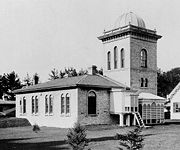 |
| Former Upper Canada College Upper Canada College Upper Canada College , located in midtown Toronto, Ontario, Canada, is an independent elementary and secondary school for boys between Senior Kindergarten and Grade Twelve, operating under the International Baccalaureate program. The secondary school segment is divided into ten houses; eight are... campus (1854); additions to Resident School House, 1856; new Porter's Lodge, Bursar's Office, gates, fences and outbuildings (1857) |
1854-7 | Frederick William Cumberland Frederick William Cumberland Frederick William Cumberland was a Canadian engineer, architect and political figure. He represented the riding of Algoma in the 1st and 2nd Ontario Parliaments and in the Canadian House of Commons from 1871 to 1872.... and William George Storm William George Storm William George Storm was a Canadian architect who designed a number of prominent monuments in Toronto.He was born in England and immigrated to Canada while still a child and was raised in Cobourg, Ontario. His father was a contractor and introduced him to the building trade. He apprenticed first... |
Gothic Revival architecture Gothic Revival architecture The Gothic Revival is an architectural movement that began in the 1740s in England... |
King and Simcoe Streets in downtown Toronto Downtown Toronto Downtown Toronto is the central business district of Toronto, Ontario, Canada. It is approximately bounded by Bloor Street to the north, Lake Ontario to the south, the Don River to the east, and Bathurst Street to the west... |
 |
|
| University College, University of Toronto University College, University of Toronto University College is a constituent college of the University of Toronto, created in 1853 specifically as an institution of higher learning free of religious affiliation. It was the founding member of the university's modern collegiate system, and its secularism contrasted with contemporary... |
1856–1859 | Frederick William Cumberland Frederick William Cumberland Frederick William Cumberland was a Canadian engineer, architect and political figure. He represented the riding of Algoma in the 1st and 2nd Ontario Parliaments and in the Canadian House of Commons from 1871 to 1872.... and William George Storm William George Storm William George Storm was a Canadian architect who designed a number of prominent monuments in Toronto.He was born in England and immigrated to Canada while still a child and was raised in Cobourg, Ontario. His father was a contractor and introduced him to the building trade. He apprenticed first... ; David Dick (1892) |
Norman Norman architecture About|Romanesque architecture, primarily English|other buildings in Normandy|Architecture of Normandy.File:Durham Cathedral. Nave by James Valentine c.1890.jpg|thumb|200px|The nave of Durham Cathedral demonstrates the characteristic round arched style, though use of shallow pointed arches above the... Romanesque Romanesque Revival architecture Romanesque Revival is a style of building employed beginning in the mid 19th century inspired by the 11th and 12th century Romanesque architecture... |
15 | 15 King's College Circle, University of Toronto University of Toronto The University of Toronto is a public research university in Toronto, Ontario, Canada, situated on the grounds that surround Queen's Park. It was founded by royal charter in 1827 as King's College, the first institution of higher learning in Upper Canada... , Toronto, Ontario |
 |
| University College, University of Toronto University College, University of Toronto University College is a constituent college of the University of Toronto, created in 1853 specifically as an institution of higher learning free of religious affiliation. It was the founding member of the university's modern collegiate system, and its secularism contrasted with contemporary... Croft House |
1859 | Frederick William Cumberland Frederick William Cumberland Frederick William Cumberland was a Canadian engineer, architect and political figure. He represented the riding of Algoma in the 1st and 2nd Ontario Parliaments and in the Canadian House of Commons from 1871 to 1872.... (Design) William George Storm William George Storm William George Storm was a Canadian architect who designed a number of prominent monuments in Toronto.He was born in England and immigrated to Canada while still a child and was raised in Cobourg, Ontario. His father was a contractor and introduced him to the building trade. He apprenticed first... ; |
Norman Norman architecture About|Romanesque architecture, primarily English|other buildings in Normandy|Architecture of Normandy.File:Durham Cathedral. Nave by James Valentine c.1890.jpg|thumb|200px|The nave of Durham Cathedral demonstrates the characteristic round arched style, though use of shallow pointed arches above the... Romanesque Romanesque Revival architecture Romanesque Revival is a style of building employed beginning in the mid 19th century inspired by the 11th and 12th century Romanesque architecture... |
2 | Kings College Circle, University of Toronto University of Toronto The University of Toronto is a public research university in Toronto, Ontario, Canada, situated on the grounds that surround Queen's Park. It was founded by royal charter in 1827 as King's College, the first institution of higher learning in Upper Canada... , Toronto, Ontario |
|
| Chapel of St. James-the-Less, St. James Cemetery (Toronto) St. James Cemetery (Toronto) The Anglican St. James Cemetery is the oldest cemetery in Toronto still in operation. Opened in 1844 as the burial ground for St. James Cathedral. To date over 89,000 interments and 75,000 cremations have taken place at the cemetery. Recognizing the growing trend towards cremation throughout the... |
1860 | Frederick William Cumberland Frederick William Cumberland Frederick William Cumberland was a Canadian engineer, architect and political figure. He represented the riding of Algoma in the 1st and 2nd Ontario Parliaments and in the Canadian House of Commons from 1871 to 1872.... and William George Storm William George Storm William George Storm was a Canadian architect who designed a number of prominent monuments in Toronto.He was born in England and immigrated to Canada while still a child and was raised in Cobourg, Ontario. His father was a contractor and introduced him to the building trade. He apprenticed first... (Design) |
Romanesque Romanesque Revival architecture Romanesque Revival is a style of building employed beginning in the mid 19th century inspired by the 11th and 12th century Romanesque architecture... |
2 | Parliament Street, Toronto, Ontario | |

